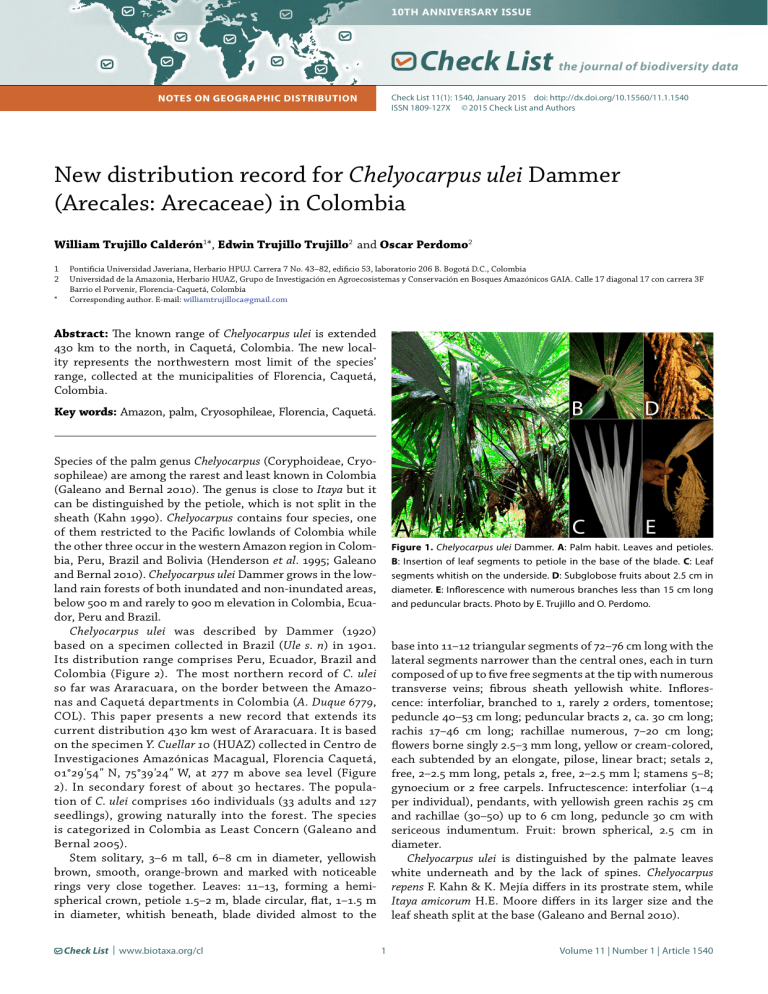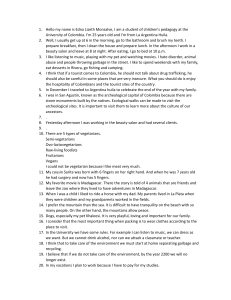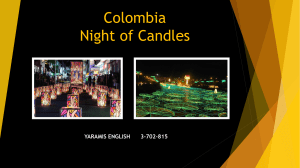
10TH ANNIVERSARY ISSUE Check List the journal of biodiversity data NOTES ON GEOGRAPHIC DISTRIBUTION Check List 11(1): 1540, January 2015 doi: http://dx.doi.org/10.15560/11.1.1540 ISSN 1809-127X © 2015 Check List and Authors New distribution record for Chelyocarpus ulei Dammer (Arecales: Arecaceae) in Colombia William Trujillo Calderón1*, Edwin Trujillo Trujillo2 and Oscar Perdomo2 1 2 * Pontificia Universidad Javeriana, Herbario HPUJ. Carrera 7 No. 43–82, edificio 53, laboratorio 206 B. Bogotá D.C., Colombia Universidad de la Amazonia, Herbario HUAZ, Grupo de Investigación en Agroecosistemas y Conservación en Bosques Amazónicos GAIA. Calle 17 diagonal 17 con carrera 3F Barrio el Porvenir, Florencia-Caquetá, Colombia Corresponding author. E-mail: [email protected] Abstract: The known range of Chelyocarpus ulei is extended 430 km to the north, in Caquetá, Colombia. The new locality represents the northwestern most limit of the species’ range, collected at the municipalities of Florencia, Caquetá, Colombia. Key words: Amazon, palm, Cryosophileae, Florencia, Caquetá. Species of the palm genus Chelyocarpus (Coryphoideae, Cryosophileae) are among the rarest and least known in Colombia (Galeano and Bernal 2010). The genus is close to Itaya but it can be distinguished by the petiole, which is not split in the sheath (Kahn 1990). Chelyocarpus contains four species, one of them restricted to the Pacific lowlands of Colombia while the other three occur in the western Amazon region in Colombia, Peru, Brazil and Bolivia (Henderson et al. 1995; Galeano and Bernal 2010). Chelyocarpus ulei Dammer grows in the lowland rain forests of both inundated and non-inundated areas, below 500 m and rarely to 900 m elevation in Colombia, Ecuador, Peru and Brazil. Chelyocarpus ulei was described by Dammer (1920) based on a specimen collected in Brazil (Ule s. n) in 1901. Its distribution range comprises Peru, Ecuador, Brazil and Colombia (Figure 2). The most northern record of C. ulei so far was Araracuara, on the border between the Amazonas and Caquetá departments in Colombia (A. Duque 6779, COL). This paper presents a new record that extends its current distribution 430 km west of Araracuara. It is based on the specimen Y. Cuellar 10 (HUAZ) collected in Centro de Investigaciones Amazónicas Macagual, Florencia Caquetá, 01°29'54" N, 75°39'24" W, at 277 m above sea level (Figure 2). In secondary forest of about 30 hectares. The population of C. ulei comprises 160 individuals (33 adults and 127 seedlings), growing naturally into the forest. The species is categorized in Colombia as Least Concern (Galeano and Bernal 2005). Stem solitary, 3–6 m tall, 6–8 cm in diameter, yellowish brown, smooth, orange-brown and marked with noticeable rings very close together. Leaves: 11–13, forming a hemispherical crown, petiole 1.5–2 m, blade circular, flat, 1–1.5 m in diameter, whitish beneath, blade divided almost to the Check List | www.biotaxa.org/cl Figure 1. Chelyocarpus ulei Dammer. A: Palm habit. Leaves and petioles. B: Insertion of leaf segments to petiole in the base of the blade. C: Leaf segments whitish on the underside. D: Subglobose fruits about 2.5 cm in diameter. E: Inflorescence with numerous branches less than 15 cm long and peduncular bracts. Photo by E. Trujillo and O. Perdomo. base into 11–12 triangular segments of 72–76 cm long with the lateral segments narrower than the central ones, each in turn composed of up to five free segments at the tip with numerous transverse veins; fibrous sheath yellowish white. Inflorescence: interfoliar, branched to 1, rarely 2 orders, tomentose; peduncle 40–53 cm long; peduncular bracts 2, ca. 30 cm long; rachis 17–46 cm long; rachillae numerous, 7–20 cm long; flowers borne singly 2.5–3 mm long, yellow or cream-colored, each subtended by an elongate, pilose, linear bract; setals 2, free, 2–2.5 mm long, petals 2, free, 2–2.5 mm l; stamens 5–8; gynoecium or 2 free carpels. Infructescence: interfoliar (1–4 per individual), pendants, with yellowish green rachis 25 cm and rachillae (30–50) up to 6 cm long, peduncle 30 cm with sericeous indumentum. Fruit: brown spherical, 2.5 cm in diameter. Chelyocarpus ulei is distinguished by the palmate leaves white underneath and by the lack of spines. Chelyocarpus repens F. Kahn & K. Mejía differs in its prostrate stem, while Itaya amicorum H.E. Moore differs in its larger size and the leaf sheath split at the base (Galeano and Bernal 2010). 1 Volume 11 | Number 1 | Article 1540 Calderón et al. | New record of Chelyocarpus ulei Dammer in Colombia Figure 1. Geographical distribution of Chelyocarpus ulei (blue circle = new record; red circle = literature record) in western Amazonia. ACKNOWLEDGMENTS Special thanks to Rodrigo Bernal who confirmed the specimen’s determination and Victor H. Gonzalez for revising the manuscript. Alexander von Humboldt, Instituto de Ciencias Naturales de la Universidad Nacional de Colombia, Ministerio de Ambiente Vivienda y Desarrollo Territorial. Galeano, G. and R. Bernal. 2010. Palmas de Colombia. Guía de Campo. Bogotá: Editorial Universidad Nacional de Colombia. 688 pp. Kahn, F. 1990. Clave para diferenciar los géneros de Palmae en la Amazonía a partir del aparato vegetativo. Bulletin de l’Institut Français d’Études Andines 19(2): 351–378 (http://www.ifeanet.org/publicaciones/articulo. php?codart=1177). Henderson, A., G. Galeano and R. Bernal. 1995. Field Guide to the Palms of the Americas. Princeton, NJ: Princeton University Press. 352 pp. LITERATURE CITED Asmussen, C.B., J. Dransfield, V. Deickmann, A.S. Barfod, J.C. Pintaud, and W.J. Baker. 2006. A new subfamily classification of the palm family (Arecaceae): evidence from plastid DNA phylogeny. Botanical Journal of the Linnean Society 151(1): 15–38 (doi: 10.1111/j.1095-8339.2006.00521.x). Dammer, C. 1920. Chelyocarpus Dammer nov. gen. Notizblatt des Botanischen Gartens und Museums zu Berlin — Dahlem 7: 395 (http://biodiversitylibrary.org/page/28703384). Galeano, G. and R. Bernal. 2005. Palmas; pp. 59–224, in: E. Calderón, G. Galeano and N. García (eds.). Libro Rojo de Plantas de Colombia. Palmas, Frailejones y Zamias. Serie Libros Rojos de Especies Amenazadas de Colombia. Volumen II. Bogotá: Instituto Check List | www.biotaxa.org/cl Authors’ contribution statement: ET and OP collected the data, WT, OP and ET made the analysis and WT wrote the text. Received: May 2014 Accepted: November 2014 Editorial responsibility: Angelo Manzatto 2 Volume 11 | Number 1 | Article 1540




